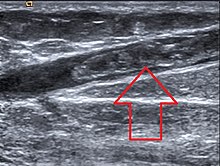User:Mr. Ibrahem/Superficial vein thrombosis
| Mr. Ibrahem/Superficial vein thrombosis | |
|---|---|
| Other names | Superficial thrombophlebitis |
 | |
| Greater saphenous vein thrombosis | |
| Specialty | Emergency medicine |
| Symptoms | Red, warm, tender area overlying a vein, hard vein[1] |
| Complications | Pulmonary embolism (PE), deep vein thrombosis (DVT)[1] |
| Usual onset | 60 years old[1] |
| Risk factors | Varicose veins, pregnancy, factor V Leiden mutation, cancer, birth control pills, obesity, recent surgery, heart failure[1] |
| Diagnostic method | Based on symptoms, confirmed by ultrasound[1] |
| Differential diagnosis | Cellulitis, lymphangitis, lymphedema, vasculitis, tendonitis[1] |
| Treatment | NSAIDs, heat,blood thinners, compression stockings[1] |
| Prognosis | Generally good outcome[1] |
| Frequency | 6 per 1,000per year[1] |
Superficial vein thrombosis (SVT) is a blood clot in a superficial vein (near the skin).[1] Symptoms typically include a red, warm, inflamed, and tender area overlying a vein.[1] The vein often feels hard.[1] Most commonly the legs are involved.[1] Complications may include pulmonary embolism (PE) and deep vein thrombosis (DVT).[1]
Risk factors include varicose veins, pregnancy, certain genetic conditions such as factor V Leiden mutation, cancer, birth control pills, obesity, recent surgery, and heart failure.[1] The underlying mechanism may involve increased clotting, decreased movement, or injury to the vein.[1] The greater saphenous vein is involved about 70% of the time, and the small saphenous vein about 15% of the time.[1] It is a type of thrombophlebitis.[2] Diagnosis is often based on symptoms and confirmed by ultrasound.[1]
In those with low risk disease treatment is often with NSAIDs, heat, and blood thinners.[1] In those with higher risk disease treatment with fondaparinux or rivaroxaban for 45 days is recommended.[1][3] Compression stockings may be recommended.[1] SVT generally has a good outcome.[1]
One study found a rate of 6 per 1,000 people per year.[1] Women are more commonly affected than men.[1] The typical age of those affected is 60.[1] Those with multiple episodes, known as Trousseau syndrome, should be investigated for cancer.[1] SVT was first described in ancient India by Sushruta.[4]
References[edit]
- ^ a b c d e f g h i j k l m n o p q r s t u v w x y z Czysz, A; Higbee, SL (January 2021). "Superficial Thrombophlebitis". PMID 32310477.
{{cite journal}}: Cite journal requires|journal=(help) - ^ "Thrombophlebitis - Symptoms and causes". Mayo Clinic. Archived from the original on 26 February 2021. Retrieved 28 February 2021.
- ^ Di Nisio, M; Wichers, IM; Middeldorp, S (25 February 2018). "Treatment for superficial thrombophlebitis of the leg". The Cochrane database of systematic reviews. 2: CD004982. doi:10.1002/14651858.CD004982.pub6. PMID 29478266.
- ^ Vaidyanathan, Subramoniam; Menon, Riju Ramachandran; Jacob, Pradeep; John, Binni (2014). Chronic Venous Disorders of the Lower Limbs: A Surgical Approach. Springer. p. 4. ISBN 978-81-322-1991-0. Archived from the original on 2021-08-29. Retrieved 2021-03-03.
